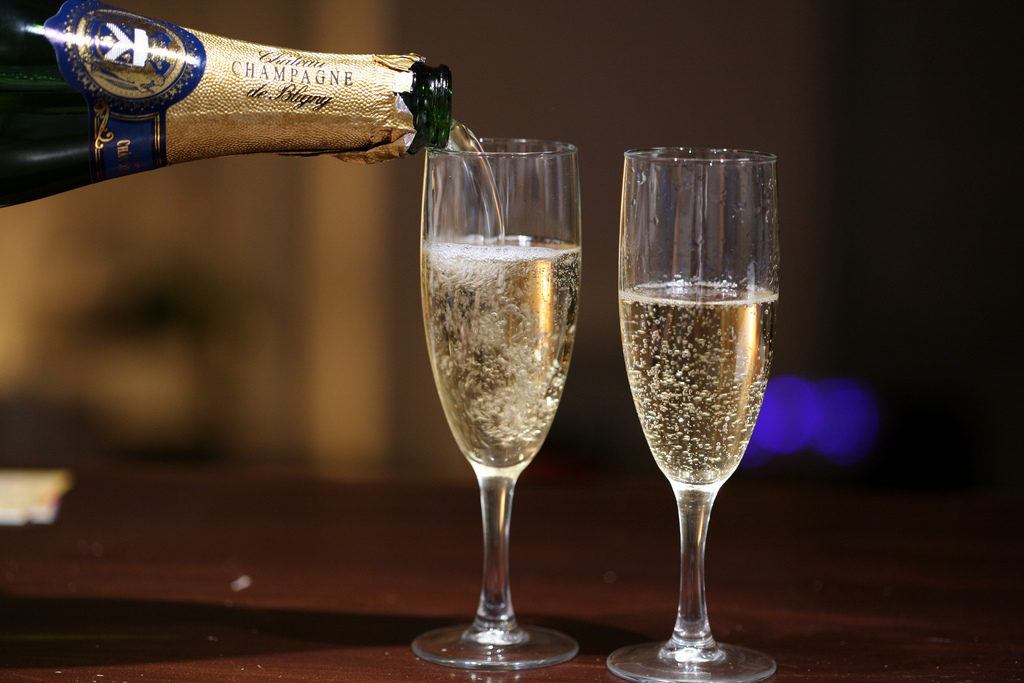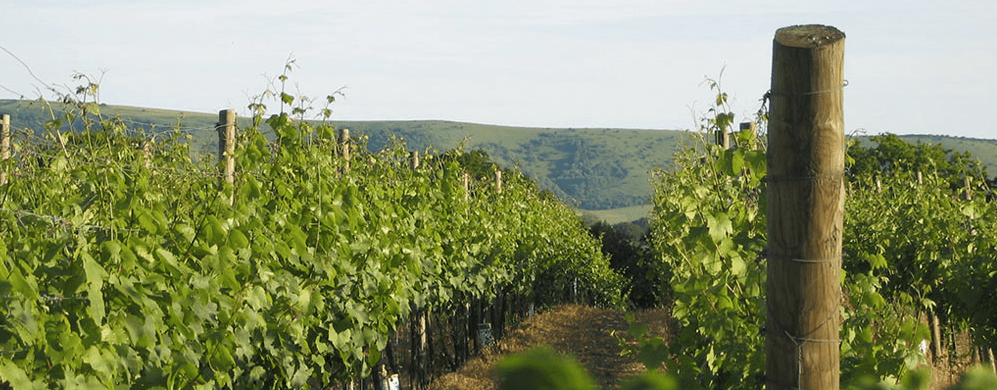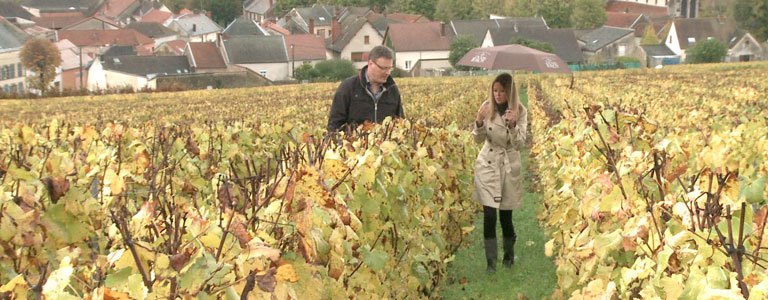Champagne from England? Mon dieu!

In the future, will all Champagne be from England?
Champagne from England? Mon dieu!
True champagne comes from grapes grown and processed in the Champagne region of France. According to the Champagne Committee, a local trade association, grapes used to make champagne have a unique set of characteristics- geography, soil, and regional climate- that cannot be found anywhere else.[i] Any change to the climate necessarily impacts the quality and yield of the champagne grape crops. While French champagne producers are scrambling to find ways to adjust to climate change, their neighbors across the English Channel have been the beneficiaries of shifting climate and now find themselves as a rapidly growing region for sparkling wine (presumably much to the chagrin of the French.)
Wine in England – Recent History
Unlike France, England does not have an extensive history of producing wine. Traditionally, England has been too cold and too rainy to allow for grapes to properly mature for harvesting for wine making. As recently as 2004, England only had 1,879 total acres of vineyards.[ii] However, due to rapidly changing climate, summers in southern England now resemble those from three decades ago in northeastern France.[iii] As a result, the English wine industry has more than doubled in little more than a decade to a total of almost 5,000 acres. It is expected to grow an additional 50% by 2020. The majority of these vineyards (66%) are producing sparkling wine similar to that produced in Champagne.[iv] The three grapes traditionally used in champagne – Chardonnay, Pinot Noir and Pinot Meunier – account for three of the top five varietals produced in England with Chardonnay and Pinot Noir being the top two (23% and 22% of all grapes grown, respectively.)[v] Based on the growing number of English vineyards producing champagne-style sparkling wine, and the increasing complications impacting growers in Champagne, one must wonder what the future will hold for sparkling wine. Surely the French do not want to see the English overtake them in production of champagne-style sparkling wines- an area of long-standing pride for the French.
Ridgeview Winery – A sign of the future?
The best example of the growing market for sparkling wine production in England is Ridgeview Winery, located roughly 90 miles north of Champagne, France. Ridgeview Winery was founded only in 1994- as compared to some wineries in France that started producing champagne in the 18th century- and delivered its first vintage in 1996 by “following the traditional winemaking methods” used by their “neighbors in France.”[vi][vii] In fact, Ridgeview selected for its initial planting French clones of the three Champagne-region grapes (Chardonnay, Pinot Noir, and Pinot Meunier) in order to best replicate a true champagne. These decisions, and indeed the decision to plant a vineyard at all, were made in no small part due to the changing climate of the region, resulting in conditions similar to those that have made Champagne such a successful grape-growing region.
The results from Ridgeview Winery have been an unquestionable success. In 2010, Ridgeview Winery unexpectedly won the Best Sparkling Wine (including those from Champagne) at the Decanter World Wine Awards. Decanter’s Tastings Director, Christelle Guibert, noted that the award “unequivocally rubberstamps England’s membership to that exclusive club of truly world class, sparkling wine producers.”[viii] As further proof of the success of Ridgeview Winery and English sparkling wines, 10 Downing Street (the home of the UK Prime Minister) recently made Ridgeview Winery and Chapel Down (another English winery) the official sparkling wines for state-sponsored receptions, marking the first time a non-Champagne has been selected.[ix] While England still has a long way to go to catch up to Champagne in both production volume and prestige, changing climate is continuing to create opportunities for English vineyards to increase their marketshare while other established sparkling wine regions, particularly Champagne, struggle to deal with the complications caused by climate change.
What’s next?
It is clear that climate change is opening new opportunities for vineyards in England while simultaneously straining existing vineyards in France. Winemaking is still in a fledgling state in England as English wines account for less than 1% of the total UK wine market. However, as climate change continues to increase temperatures in England, the total area viable for grape growing will continue to expand northward. There is such significant potential for growth that one former UK hedge fund manager quit his career and invested £10 million of his own money to build a new winery.[x] Winemakers and investors alike must realize the potential of England to become a significant producer of wine as its climate continues to change. Individual wineries, such as Ridgeview, should expand their operations and investments into new wineries should increase.
Unfortunately, for lovers of true champagne, a pessimistic blog recommends “buying your favorite Champagnes while you still can.”[xi] In the future, all “Champagne” may be produced in England.
[i] No author, “Champagne wine”, The Comité Champagne, http://www.champagne.fr/4/72/94
[ii] Christopher Barnes, “Climate Change and English Sparkling Wine”, Grape Collective, April, 1st, 2016: https://grapecollective.com/articles/climate-change-and-english-sparkling-wine
[iii] Mark Ellwood, “Three Ways to Beat Champagne’s Climate-Change Problem”, The Wall Street Journal, October 18th, 2016: http://www.wsj.com/articles/three-ways-to-beat-champagnes-climate-change-problem-1476799848
[iv] No author, “A Few Facts and Figures About English and Welsh Wines”, English Wine Producers: http://www.englishwineproducers.co.uk/files/7014/6399/8219/Instant_Fact_Sheet_2016.pdf
[v] Ibid
[vi] Ridgeview Winery Company Website, http://www.ridgeview.co.uk/pages/history-of-ridgeview/8999
[vii] Gosset Champagne Company Website, http://www.champagne-gosset.com/eng/The-House/The-GOSSET-Tradition
[viii] Adam Lecher, “English sparkling beats top Champagnes at Decanter World Wine Awards”, Decanter Magazine: http://www.decanter.com/wine-news/english-sparkling-beats-top-champagnes-at-decanter-world-wine-awards-50948/
[ix] Lucy Shaw, “Downing Street Backs English Sparkling Wine”, the Drinks Business, May 26th, 2016: http://www.thedrinksbusiness.com/2016/05/downing-street-backs-english-sparkling-wine/
[x] Euny Hony, “In the Future, Your Champagne Will Come From England” The Atlantic, September 24, 2012: http://www.theatlantic.com/international/archive/2012/09/in-the-future-your-champagne-will-come-from-england/262784/
[xi] Ross Taylor, “Climate and Taste”, Premiere Champagne, August 31st, 2016: http://blog.premierchampagne.com/2016/08/climate-and-taste.html?view=timeslide






This is a great topic and I think Alec did a great job with his analysis. I find it hard to believe that the French would just give up their champagne production and wonder if there are any things France can do to modify their vines to be more resistant to climate change. I read that the warmer climate makes the vines more vulnerable to fungus, virus, and other diseases. In addition, the lack of water causes the grapes to dry up and lose acidity. Can France look at more complex irrigation systems and perhaps slightly modify the vines to strengthen them against the diseases? Or would these solutions ruin what is so wonderful about french champagne?
Great article! This post shows how climate change can create some unique new opportunities for businesses to grow, and how global warming can shift weather dependent businesses to northern locations.
However, climate change does not only create an increase in global temperatures, it also creates great instability and variability in weather trends. Most problems for Champagne region in recent years derived from increasing temperatures. But surprisingly, last years’ crop output dropped significantly due to frost and hailstorms (http://www.bloomberg.com/news/articles/2016-07-22/france-wine-out-drops-as-hail-frost-hit-champagne-burgundy).
Unfortunately, this instability can signal that moving Champagne production to UK is only a temporary solution with a limited lifetime. Adapting to weather changes and variability can prove more effective in the long run, and can be done by advanced fertilizers and pesticides, bio-engineering, advanced irrigation, and more.
Interesting article Alec! I believe there are startups which are developing processes to synthetically mimic wine that has the look and taste of the original. In order to prevent champagne from completely shifting base to England and competition from mimicking French champagne, French vineyards can consider linking with a company like the one mentioned here (http://www.wsj.com/articles/three-ways-to-beat-champagnes-climate-change-problem-1476799848) to synthetically create French champagne to become “closer to the original.”
While sparkling wine is great, there still is something special about having a glass of champagne. This article makes me wonder if there are no other ways the French can combat climate change to help the champagne region instead of giving up the market share to the Brits. I have read that the warmer and dryer summers can actually lead to less acidity, higher alcohol content and make it easier to produce (http://www.reuters.com/article/us-climatechange-summit-champagne-idUSKCN0SZ1YX20151110). Perhaps there is some good that these growers can find from the change in climate while still focusing on what they can do to combat the change. I love the ingenuity of the British growers in entering the market, but I would like to save Champagne if possible.
Thanks Alec, this is very insightful! I guess wine bottles may soon start having names of old Lords and Baronesses, as an indicator of quality!
However, I want to understand that how does the flip side work out for France? Given, that an average French consumes ~45-50 litres of wine in a year amount to almost $1000/year (at $20/bottle). This is almost 3% of per capita GDP (France is approximately at $35000 per capita).
If there’s a big shift in the industry, France’s economy might shifting from exporting wines to importing them, leading to huge market gap in the country. Maybe, we should too open a vineyard!
Great post, Alec! I like Maria’s idea of looking for ways to genetically modify the vines to produce grapes more resistant to volatile weather conditions; perhaps the French champagne producers should reach out to Indigo for assistance! Alternatively, maybe there could be opportunities for the French producers to work with the English newcomers to the industry and attempt to reproduce the taste of traditional champagne (perhaps by using French seeds and transporting French soil to England).
I also wonder how quickly optimal growing conditions will keep moving North… maybe we should start setting up vineyards in Norway a few years from now!